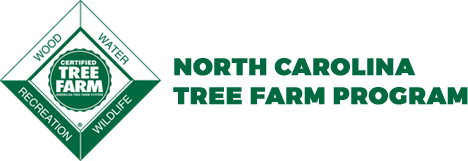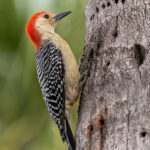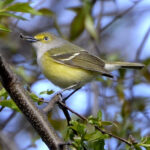Bottomland Birds
Bottomland forests are especially important habitat for both resident and migratory birds traveling between North America and the tropics. As a result, bottomland forests are also prime bird-watching locations year-round. Learn about birds of North Carolina’s hardwood forests here.
Why Bottomland Hardwood Forests Matter to Landbird Migration (North Carolina Audubon)
This post is part of a four-part series on Audubon’s Forest Landbird Legacy Program’s Eastern Forests initiative, an innovative program that enables landowners and foresters to help support birds that depend on forested landscapes along the Atlantic Flyway, training them in bird-friendly forestry practices and promoting legislation that provides incentives for forest preservation.
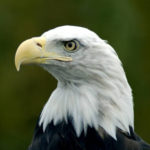 |
BALD EAGLE
|
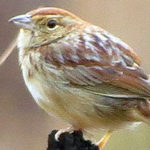 |
BACHMAN’S SPARROW
|
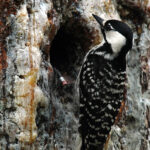 |
RED-COCKADED WOODPECKER (RCW)
|
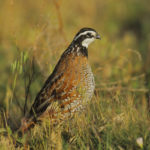 |
NORTHERN BOBWHITE QUAIL (Colinus virginianus)Although it has no official protection designation, Northern bobwhite quail is a species of interest for many natural resource professionals and forest landowners. The loss of suitable habitat has had a crushing impact on Northern bobwhite quail, and populations across North Carolina have declined for many years and remain near all-time lows. This bird is particularly scarce in the piedmont and mountains. |
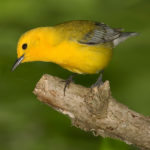 |
PROTHONOTARY WARBLER (Protonotaria citrea)In North Carolina, the Prothonotary Warbler is a common bird of Coastal Plain swamps, but is much less numerous farther inland, and is apparently absent in the mountains as a breeder. It inhabits swamps, bottomlands, nonriverine forests, wooded beaver ponds and other wet habitats with some dead trees for nesting in existing cavities. Audubon has identified the Prothonotary Warbler as one of 32 priority-bird species within the Atlantic Flyway. However because its habitat actually appears to be increasing in the East, owing to an increase in beavers and beaver ponds, the Prothonotary Warbler appears to be slightly increasing, as well. |
 |
RED-HEADED WOODPECKER (Melanerpes erythrocephalus)The Red-cockaded woodpecker is a year-round resident of North Carolina that prefers open forests with clear understories, particularly areas with dead and dying trees. They forage for insects, fruit and seeds on the ground and up to 30 feet above ground during the summer, and even higher during winter months. |
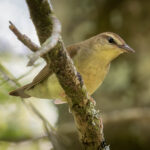 |
SWAINSON’S WARBLER (Limnothlypis swainsonii)Swainson’s warblers breed in southeastern forests with well-developed understory, especially bottomland hardwood forests and moist mountain ravines, but also in young pine plantations in some areas. In North Carolina it is a summer resident and breeds throughout most of the coastal plains and mountains. It is also considered a summer resident in the Piedmont but scarce. This bird tends to remain hidden in the forest understory and the best way to find it is to listen for its bold song. |
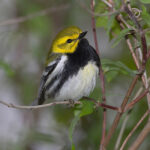 |
BLACK THROATED GREEN WARBLER (Setophaga virens)In North Carolina the black throated green warbler is a summer resident in the mountains region and is considered common. A separate subspecies called “Wayne’s Warbler” nests in cypress swamps of the lower coastal plain. The Wayne’s warbler is listed by NC Wildlife Resources Commission as State Endangered. Getting a good look at this bird is often difficult because they usually remain high in the canopy, but it can be tracked down by its song that birders describe as “trees trees I love trees.” |
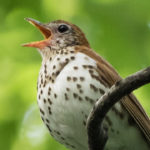 |
WOOD THRUSH (Hylocichla mustelina)The Wood Thrush breeds and nests in all 100 counties of North Carolina but its numbers are declining across its range. Their breeding habitat is typically hardwood canopy and must contain a moderate scatter of saplings or small trees, shrubs, and a rich herb layer. Wood Thrushes are more numerous in damp forests and near streams than in drier woods but will also nest in suburban areas where there are enough large trees. After migration, they winter in understory of lowland tropical forest. |
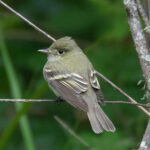 |
ACADIAN FLYCATCHER (Empidonax virescens)The Acadian flycatcher nests in all 100 North Carolina counties. It is found primarily in moist hardwood forests (always avoiding pines), usually near a creek or in bottomland forests, and less so in deep swamps. However, it is not a canopy bird, but it forages in the understory, usually about 20-50 feet above ground. Nests are often built on down-hanging branches directly over a creek. |
|
|
RED BELLIED WOODPECKER (Melanerpes carolinus)Red-bellied woodpeckers are common throughout the coastal plain and piedmont regions of the state and fairly common all year at lower elevations of the mountain region, up to about 3,000 feet. These birds mainly search out arthropods on tree trunks. They may also catch insects in flight. Their breeding habitat is usually deciduous forest, and they nest in the decayed cavities of dead trees, old stumps, or in live trees that have softer wood such as elms, maples, or willows. |
|
|
WHITE-EYED VIREO (Vireo griseus)Though it can be somewhat hard to see, the white-eyed vireo is common over much or most of North Carolina, but much less so in the mountains. Habitats include thickets around a lake or pond shore, openings such as road margins through a bottomland or swamp, and regenerating clearcuts. In winter, it favors dense evergreen cover, so there is some change of habitat from the summer season. At all times, it is usually found in the shade of dense cover, seldom more than 25 feet from the ground. It is our only breeding species of vireo that favors shrub and understory layers. |
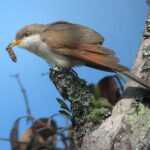 |
Yellow-billed Cuckoo (Coccyzus americanus)This bird is found in the North Carolina Piedmont and Coastal Plain. It prefers forests with a lot of moisture, such as bottomlands, swamps and forests adjoining streams and lakes. The yellow-billed cuckoo has a call that sounds like knocking, but in late summer they tend to have a dove-sounding coo. |
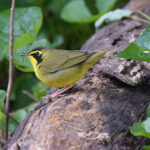 |
Kentucky Warbler (Geothlypis formosa)The Kentucky warbler is a shy warbler of deciduous forests with thick understory. Often found in swampy areas or near slow-moving streams, they can be spotted in North Carolina from April to October. It spends winters in Mexico and Central America. Kentucky Warblers are bright yellow below and olive-green above with black crowns and black inverted triangles below their eyes. Females have grayer caps rather than black. They eat insects and their larvae and spiders. |
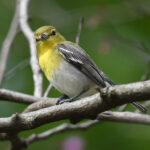 |
Yellow throated Vireo (Vireo flavifrons)Yellow throated Vireos are a summer resident over much of the state and like most migratory songbirds, it winters south of the United States. In North Carolina this bird can be seen mainly from early April to late September in mature, mostly deciduous forests and wooded streamsides. Males and females look as if they are wearing bright yellow spectacles on their olive-green head. The throat and chest match their spectacles, but the lower belly is bright white. Two white bars mark the gray wings. This is a sluggish bird, usually remaining well up in the canopy, not moving much, often requiring patience to see well. |
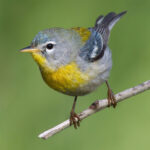 |
Northern Parula Warbler (Setophaga americana)Like most other warbler species, Northern Parulas spend the breeding season in North Carolina before heading to Central America and the Caribbean for winter. They are mainly spotted from mid-March to October, but a few hang around all year. These warblers are a colorful contrast of blueish-gray and yellow. They are bluish-gray on the back with a yellow patch on the back and with two white wingbars. You can find Northern Parulas feeding on insects high up in deciduous forests. Nests of Northern Parula are made in long clumps of lichen and moss that drape from the branches. The best way to spot them is by looking up at large clumps of hanging moss in the summer. |
 |
Yellow-throated Warbler (Setophaga dominica)Yellow-throated Warblers are usually spotted in North Carolina during the breeding season and are mainly seen from March to mid-October. Yellow-throated Warblers have gray and white bodies with black stripes and bright yellow throats. They have white bellies and tails when looking from below. Females and juveniles are paler. You can find Yellow-throated Warblers usually at the top of pine trees looking for insects, but they may forage lower down during migration. |
